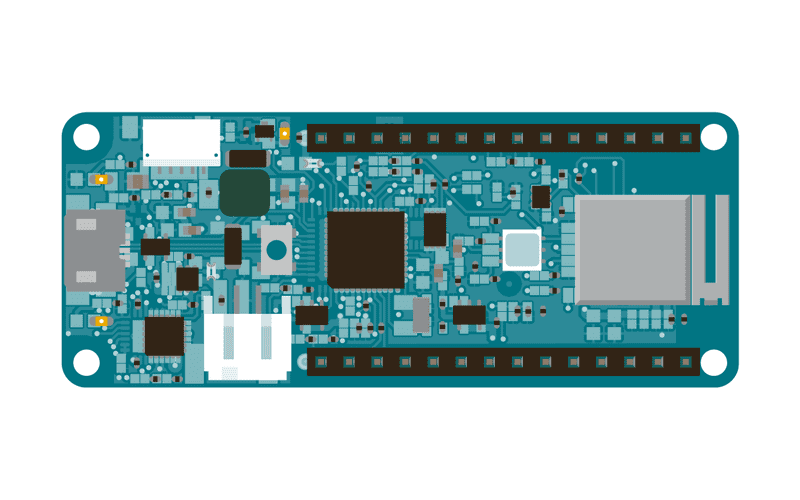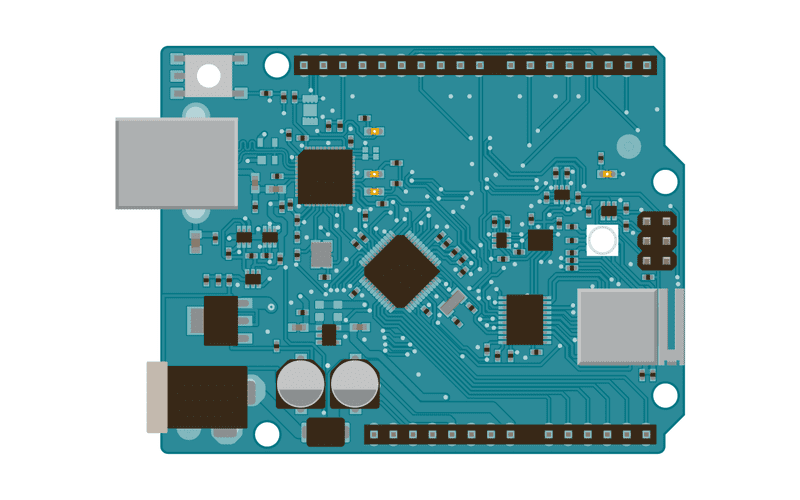WiFi Chat Server
A simple server that distributes any incoming messages to all connected clients. To use, open a terminal window, telnet to your WiFi module's IP address, and type away. Any incoming text will be sent to all connected clients (including the one typing). Additionally, you will be able to see the client's input in your Arduino Software (IDE) serial monitor as well.
Hardware Required
Circuit
The WiFi module is integrated on your board and you don't need any special circuitry to get this tutorial to work.
 Arduino MKR WiFi 1010
Arduino MKR WiFi 1010
 Arduino MKR VIDOR 4000
Arduino MKR VIDOR 4000
 Arduino UNO WiFi Rev.2
Arduino UNO WiFi Rev.2
Please note: these three boards use dedicated pins to communicate and select the WiFi module, therefore you have no restriction in the usage of the available digital pins connected to the header pins.
Code
You should have access to a 802.11b/g wireless network that connects to the internet for this example. You will need to change the network settings in the sketch to correspond to your particular networks SSID.
For networks using WPA/WPA2 Personal encryption, you need the SSID and password. The shield will not connect to networks using WPA2 Enterprise encryption.
WEP network passwords are hexadecimal strings known as keys. A WEP network can have 4 different keys; each key is assigned a "Key Index" value. For WEP encrypted networks, you need the SSID, the key, and key number.
/*
Chat Server
A simple server that distributes any incoming messages to all
connected clients. To use telnet to your device's IP address and type.
You can see the client's input in the serial monitor as well.
This example is written for a network using WPA encryption. For
WEP or WPA, change the Wifi.begin() call accordingly.
Circuit:
* Board with NINA module (Arduino MKR WiFi 1010, MKR VIDOR 4000 and UNO WiFi Rev.2)
created 18 Dec 2009
by David A. Mellis
modified 31 May 2012
by Tom Igoe
*/
#include <SPI.h>
#include <WiFiNINA.h>
#include "arduino_secrets.h"
///////please enter your sensitive data in the Secret tab/arduino_secrets.h
char ssid[] = SECRET_SSID; // your network SSID (name)
char pass[] = SECRET_PASS; // your network password (use for WPA, or use as key for WEP)
int keyIndex = 0; // your network key Index number (needed only for WEP)
int status = WL_IDLE_STATUS;
WiFiServer server(23);
boolean alreadyConnected = false; // whether or not the client was connected previously
void setup() {
//Initialize serial and wait for port to open:
Serial.begin(9600);
while (!Serial) {
; // wait for serial port to connect. Needed for native USB port only
}
// check for the WiFi module:
if (WiFi.status() == WL_NO_MODULE) {
Serial.println("Communication with WiFi module failed!");
// don't continue
while (true);
}
String fv = WiFi.firmwareVersion();
if (fv < WIFI_FIRMWARE_LATEST_VERSION) {
Serial.println("Please upgrade the firmware");
}
// attempt to connect to Wifi network:
while (status != WL_CONNECTED) {
Serial.print("Attempting to connect to SSID: ");
Serial.println(ssid);
// Connect to WPA/WPA2 network. Change this line if using open or WEP network:
status = WiFi.begin(ssid, pass);
// wait 10 seconds for connection:
delay(10000);
}
// start the server:
server.begin();
// you're connected now, so print out the status:
printWifiStatus();
}
void loop() {
// wait for a new client:
WiFiClient client = server.available();
// when the client sends the first byte, say hello:
if (client) {
if (!alreadyConnected) {
// clead out the input buffer:
client.flush();
Serial.println("We have a new client");
client.println("Hello, client!");
alreadyConnected = true;
}
if (client.available() > 0) {
// read the bytes incoming from the client:
char thisChar = client.read();
// echo the bytes back to the client:
server.write(thisChar);
// echo the bytes to the server as well:
Serial.write(thisChar);
}
}
}
void printWifiStatus() {
// print the SSID of the network you're attached to:
Serial.print("SSID: ");
Serial.println(WiFi.SSID());
// print your board's IP address:
IPAddress ip = WiFi.localIP();
Serial.print("IP Address: ");
Serial.println(ip);
// print the received signal strength:
long rssi = WiFi.RSSI();
Serial.print("signal strength (RSSI):");
Serial.print(rssi);
Serial.println(" dBm");
}See Also:
WiFi NINA library - Your reference for the WiFi NINA Library.
Arduino MKR WiFi 1010 - Product details for the Arduino MKR WiFi 1010 board.
Arduino MKR VIDOR 4000 - Product details for the Arduino MKR VIDOR 4000 board.
Arduino UNO WiFi Rev.2 - Product details for the Arduino UNO WiFi Rev.2 board.
AP_SimpleWebServer : A simple web server to manage a LED with AP feature
ConnectNoEncryption : Demonstrates how to connect to an open network
ConnectWithWEP : Demonstrates how to connect to a network that is encrypted with WEP
ConnectWithWPA : Demonstrates how to connect to a network that is encrypted with WPA2 Personal
ScanNetworks : Displays all WiFi networks in range
ScanNetworksAdwanced : Displays all WiFi networks, also the encrypted ones, in range
SimpleWebServerWiFi : A simple web server to manage a LED
WiFiPing : Demonstrates how to ping a website or IP address
WiFiSSLClient : Connect to a website using SSL
UdpNTPClient : Query a Network Time Protocol (NTP) server using UDP
WiFiUdpSendReceiveString : Send and receive a UDP string
WiFiWebClient : Connect to a remote webserver
WiFiWebClientRepeating : Make repeated HTTP calls to a webserver
WiFiWebServer : Serve a webpage from the WiFi module
Last revision 2018/07/12 by SM